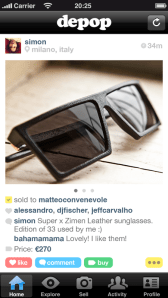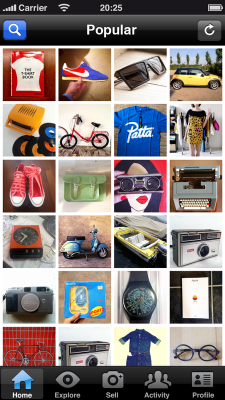Snap a photo of the item you want to sell, write a short description, and set a price. Sounds familiar, right? After soft-launching in Italy where it was incubated, Depop [iTunes] gets its official launch today with an iOS app that, at first glance, is the spitting image of other “flea market” mobile apps. However, the company says that its ultimate competitor is probably Ebay, while it also has vintage design and craft-oriented marketplace Etsy firmly in its sights.
In the “flea market” mobile app space, it compete with Shpock [iTunes], Stuffle [iTunes] and Osom [iTunes] in Europe, or Rumgr [iTunes] and Yardsale [iTunes] in the U.S., or Chile’s Vendly [iTunes].
Selling an item via the Depop marketplace is free and follows a familiar user-path. You take a photo using your iOS device (or choose an existing one from your camera roll) and upload it. Then you enter a description and other information such as price, location and delivery details. You also have the option to share the Depop listing via Twitter and Facebook. And that’s pretty much it.
Interested buyers can search for or browse items — the app utilises a grid view of photo thumbnails in a nod towards the Pinterestization of the web. Once they spot something of interest they can read further details and start conversing with the seller to ask questions and even negotiate on price. Once a sale is agreed, the seller presses the “sell” button and a “buy” button then appears for the buyer. In that way, the seller has total control of who to sell to.
 Unlike many other mobile “flea markets”, Depop does handle payment (via credit card/PayPal), taking a small commission, though the seller and buyer can still choose to exchange cash if handing over an item in person and bypass this aspect of the app, therefore doing business for free.
Unlike many other mobile “flea markets”, Depop does handle payment (via credit card/PayPal), taking a small commission, though the seller and buyer can still choose to exchange cash if handing over an item in person and bypass this aspect of the app, therefore doing business for free.
Another aspect that potentially sets Depop apart from others is that — for now — it isn’t location-based, thus placing less emphasis on local. Hence the need to support online payments. Instead, social is at its heart. Users can follow other users, making it easy to see when your friends have something for sale, though this is in no way unique to Depop.
Finally, the app isn’t only about individuals selling items. Depop is also pitching itself as an additional retail channel for independent shops and brands, and this is where the app begins to encroach more and more on something like Etsy. At launch, Depop cites UK independent stores Beach London, Mint Vintage and Never Fully Dressed as partners.
Since its soft launch in Italy 8 months ago, the app claims 50k registered users, and 350k items listed for sale.
Also noteworthy is Depop’s backers. After graduating from Italian incubator H-Farm, the 2011-founded startup has raised €1 million in funding from Balderton Capital and Holtzbrinck Ventures. It’s also since relocated to East London’s “Silicon Roundabout” area (apparently it was a toss up between London and Berlin, but London won).
The company is founded by CEO Simon Beckerman. He was previously founder of PIG Magazine, an indie fashion magazine, as well as Super Sunglasses. Meanwhile, the Depop team has grown from three to fourteen employees in the last four months and is hiring.
